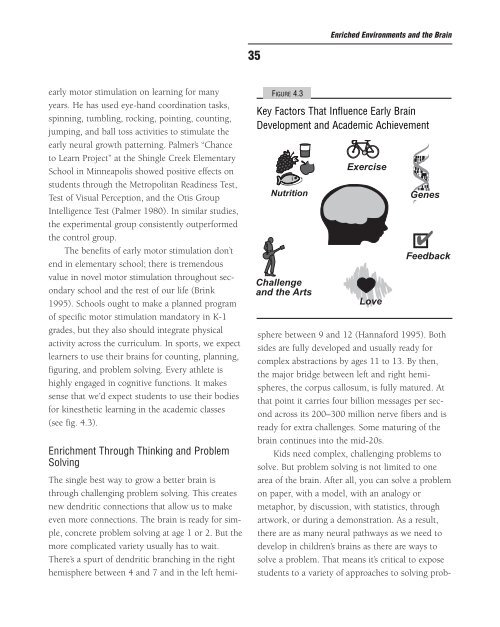Create successful ePaper yourself
Turn your PDF publications into a flip-book with our unique Google optimized e-Paper software.
early motor stimulation on learn<strong>in</strong>g for many<br />
years. He has used eye-hand coord<strong>in</strong>ation tasks,<br />
sp<strong>in</strong>n<strong>in</strong>g, tumbl<strong>in</strong>g, rock<strong>in</strong>g, po<strong>in</strong>t<strong>in</strong>g, count<strong>in</strong>g,<br />
jump<strong>in</strong>g, and ball toss activities to stimulate <strong>the</strong><br />
early neural growth pattern<strong>in</strong>g. Palmer’s “Chance<br />
to Learn Project” at <strong>the</strong> Sh<strong>in</strong>gle Creek Elementary<br />
School <strong>in</strong> M<strong>in</strong>neapolis showed positive effects on<br />
students through <strong>the</strong> Metropolitan Read<strong>in</strong>ess Test,<br />
Test of Visual Perception, and <strong>the</strong> Otis Group<br />
Intelligence Test (Palmer 1980). In similar studies,<br />
<strong>the</strong> experimental group consistently outperformed<br />
<strong>the</strong> control group.<br />
The benefits of early motor stimulation don’t<br />
end <strong>in</strong> elementary school; <strong>the</strong>re is tremendous<br />
value <strong>in</strong> novel motor stimulation throughout secondary<br />
school and <strong>the</strong> rest of our life (Br<strong>in</strong>k<br />
1995). Schools ought to make a planned program<br />
of specific motor stimulation mandatory <strong>in</strong> K-1<br />
grades, but <strong>the</strong>y also should <strong>in</strong>tegrate physical<br />
activity across <strong>the</strong> curriculum. In sports, we expect<br />
learners to use <strong>the</strong>ir bra<strong>in</strong>s for count<strong>in</strong>g, plann<strong>in</strong>g,<br />
figur<strong>in</strong>g, and problem solv<strong>in</strong>g. Every athlete is<br />
highly engaged <strong>in</strong> cognitive functions. It makes<br />
sense that we’d expect students to use <strong>the</strong>ir bodies<br />
for k<strong>in</strong>es<strong>the</strong>tic learn<strong>in</strong>g <strong>in</strong> <strong>the</strong> academic classes<br />
(see fig. 4.3).<br />
Enrichment Through Th<strong>in</strong>k<strong>in</strong>g and Problem<br />
Solv<strong>in</strong>g<br />
The s<strong>in</strong>gle best way to grow a better bra<strong>in</strong> is<br />
through challeng<strong>in</strong>g problem solv<strong>in</strong>g. This creates<br />
new dendritic connections that allow us to make<br />
even more connections. The bra<strong>in</strong> is ready for simple,<br />
concrete problem solv<strong>in</strong>g at age 1 or 2. But <strong>the</strong><br />
more complicated variety usually has to wait.<br />
There’s a spurt of dendritic branch<strong>in</strong>g <strong>in</strong> <strong>the</strong> right<br />
hemisphere between 4 and 7 and <strong>in</strong> <strong>the</strong> left hemi-<br />
35<br />
FIGURE 4.3<br />
Enriched Environments and <strong>the</strong> <strong>Bra<strong>in</strong></strong><br />
Key Factors That Influence Early <strong>Bra<strong>in</strong></strong><br />
Development and Academic Achievement<br />
Nutrition<br />
Challenge<br />
and <strong>the</strong> Arts<br />
Exercise<br />
Genes<br />
Feedback<br />
sphere between 9 and 12 (Hannaford 1995). Both<br />
sides are fully developed and usually ready for<br />
complex abstractions by ages 11 to 13. By <strong>the</strong>n,<br />
<strong>the</strong> major bridge between left and right hemispheres,<br />
<strong>the</strong> corpus callosum, is fully matured. At<br />
that po<strong>in</strong>t it carries four billion messages per second<br />
across its 200–300 million nerve fibers and is<br />
ready for extra challenges. Some matur<strong>in</strong>g of <strong>the</strong><br />
bra<strong>in</strong> cont<strong>in</strong>ues <strong>in</strong>to <strong>the</strong> mid-20s.<br />
Kids need complex, challeng<strong>in</strong>g problems to<br />
solve. But problem solv<strong>in</strong>g is not limited to one<br />
area of <strong>the</strong> bra<strong>in</strong>. After all, you can solve a problem<br />
on paper, with a model, with an analogy or<br />
metaphor, by discussion, with statistics, through<br />
artwork, or dur<strong>in</strong>g a demonstration. As a result,<br />
<strong>the</strong>re are as many neural pathways as we need to<br />
develop <strong>in</strong> children’s bra<strong>in</strong>s as <strong>the</strong>re are ways to<br />
solve a problem. That means it’s critical to expose<br />
students to a variety of approaches to solv<strong>in</strong>g prob-<br />
❆<br />
Love



